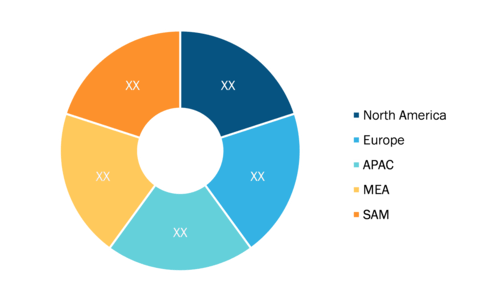Introduction of Autonomous Vehicles and Connected Car Infrastructure Provide Lucrative Opportunities for Edge Computing Market
According to our new research study on “Edge Computing Market Forecast to 2028 – COVID-19 Impact and Global Analysis – by Component, Organization Size, Application, and Industry,” the edge computing market is projected to reach US$ 132.11 billion by 2028 from US$ 40.84 billion in 2022; the market size is estimated to grow at a CAGR of 21.6% from 2022 to 2028.
Autonomous vehicles can connect to the edge to improve safety, enhance efficiency, reduce accidents, and decrease traffic congestion. These cars are equipped with various sensors, and thus, large volumes of data are created, which need to be processed instantly. Machine learning (ML) algorithms used in self-driving cars extract insights from raw data to determine road conditions and make decisions based on them. The growing integration of vehicle-to-everything (V2X) technology in autonomous vehicles would offer potential opportunities for the edge computing market growth in the coming years. Automotive vehicles having interactive advanced driver-assistance systems (ADAS) and cooperative intelligent transport systems (C-ITS) function as connected cars. Connected vehicle safety applications are designed to increase situation awareness and mitigate traffic accidents through vehicle-to-vehicle (V2V) and vehicle-to-infrastructure (V2I) communications. The V2X technology, which mainly focuses on vehicle-to-vehicle (V2V) and vehicle-to-infrastructure (V2I) communication, generates huge computing demands on autonomous driving edge computing systems. With a significant increase in the deployment of edge computing facilities in road infrastructure, many autonomous driving applications have started leveraging V2X communications to make the in-vehicle edge computing system efficient. A few benefits of edge computing in autonomous vehicles include optimized data, faster 5G response times, infrastructure security, and localized data caching.
Major stakeholders in the global edge computing market ecosystem are hardware suppliers, software providers, edge computing service providers, and end users. Hardware suppliers provide IoT-enabled sensors and other equipment, which enables the data collection for edge computing. ABB, Ltd. and Schneider Electric SE are a few of the prominent suppliers of IoT-enabled equipment and sensors. The software providers offer solutions that are often customized as per customer requirements. These solutions collect, disseminate, and analyze data gathered from different equipment requiring edge computing. Software providers include renowned companies such as IBM Corporation and Microsoft Corporation.
The edge computing market has been analyzed on the basis of the following segments: component, application, enterprise size, industry, and geography. Based on component, the market is further segmented into hardware, software, and services. The software segment is expected to held the largest share in the edge computing market during the forecast period. The edge computing market, by application, is subsegmented into smart cities, Industrial Internet of Things (IIoT), content delivery, augmented reality and virtual reality, and others. The smart cities segment is expected to held the largest share in the market during the forecast period. The market, by enterprise size, is subsegmented into small and medium enterprises, and large enterprises. The SMEs segment is expected to grow at the height CAGR in the market during the forecast period. The edge computing market, based on industry, is further segmented into manufacturing, energy & utility, government, IT and telecom, healthcare, retail and consumer goods, and others. The IT and telecom segment is expected to led the edge computing industry during the forecast period. In terms of geography, the edge computing market is further segmented into five major regions North America, Europe, Asia Pacific, the Middle East & Africa, and South America. North America dominated the overall market in 2021, and Europe accounted for the second-largest share of the market in 2021.
Impact of COVID-19 Pandemic on Edge Computing Market
The COVID-19 outbreak dramatically impacted the global economy during its peak in 2020, and the crisis also hampered business activities in the IT sector. The outbreak favored the edge computing market as the work-from-home model accelerated the transition to bring data processing and delivery capabilities closer to the data's source for enhancing convenience for employees working from remote locations, without altering computing intelligence and security. The pandemic compelled enterprises to rapidly move their critical workload to the cloud to ensure the seamless functioning of their businesses. With the cloud gaining momentum, enterprises began paving the way to optimize their networks, storage capacities, and agility, wherein edge computing turns out to be the perfect solution to meet the required capabilities. Reduced latency and high bandwidth; the significant emergence of advanced technologies, including the Internet of Things (IoT) and Internet of Behaviors (IoB); and the introduction of autonomous vehicles are among the prominent factors fueling the demand for edge computing. With a surge in the use of IoT devices in the post-pandemic period, enterprises have started creating and deploying the right mix of centralized and edge computing capabilities, depending on their business requirements, which have propelled the edge computing market growth.
ADLINK Technology; Amazon Web Services, Inc.; Dell Technologies; EdgeConnex Inc.; FogHorn Systems; International Business Machine Corporation; Litmus Corporation; Microsoft Corporation; The Hewlett Packard Enterprise Company; and Vapor IO, Inc are the key players operating in the edge computing market. In addition, several other market players have been analyzed to understand the overall market.
Edge Computing Market Share – by Region, 2021
Edge Computing Market Size and Forecast (2021 - 2031), Global and Regional Share, Trend, and Growth Opportunity Analysis Report Coverage: By Edge Computing 
Edge Computing Market Analysis Report By Size, Share, Growth 2031
Download Free Sample
Phone: +1-646-491-9876
Email Id: sales@theinsightpartners.com